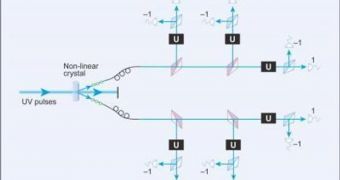According to a new research conducted by Swedish and Polish experts, photons used for quantum-data transmissions have strength in numbers. They reveal that the elementary particles, which make up quantum bits, or qubits, the basic units of a quantum computer, are much less likely to trigger the scrambling of transmitted quantum data if they work in groups of six. The methods currently used for sending and storing quantum data are extremely fragile at this point, which is one of the main reasons why endeavors to build a quantum computer of efficient quantum networks have been plagued with failure, ScienceDaily reports.
In “classic” computers, a bit is stored in one of two states, either “1” or “0.” Its value is set by convention, so that engineers can go on with constantly building increasingly advanced processors and microchips. However, photons are very different from this setup. Because they are quantum mechanical objects, they can exist in a number of states at the same time, which would roughly translate into “1,” “0” and “1 and 0” at the same time. Also, they can be entangled, a process that results in the newly formed structure holding precisely on bits of information.
Up until now, the frailty of qubits has been the main obstacle in constructing complex applications for their amazing properties. Normal, computer-stored data does not degrade very quickly, and can be transmitted successfully along, for example, fiber optics cables. But, when it comes to passing qubits through these cables, a number of factors can make them unstable and degrade them. For instance, if the materials making up the cable have a kink in them, that can destroy the data. Even temperature changes act on the photons, which results in the quantum data being scrambled beyond recovery.
The research group, led by Stockholm University expert Magnus Radmark, has now shown that entangling data in a six-photon qubit may be the way of the future. Information encoded in this manner can withstand far more “beating” than that “written” on just two photons. In their experiments, the scientists proved that their qubits were solid enough to transfer data over long distances, being able to withstand a number of external influences that would have destroyed their less-numerous predecessors. As soon as the technology to encode and decode quantum data on and from qubits is created, we will benefit from the full advantages of fast and secure quantum communication.

 14 DAY TRIAL //
14 DAY TRIAL //